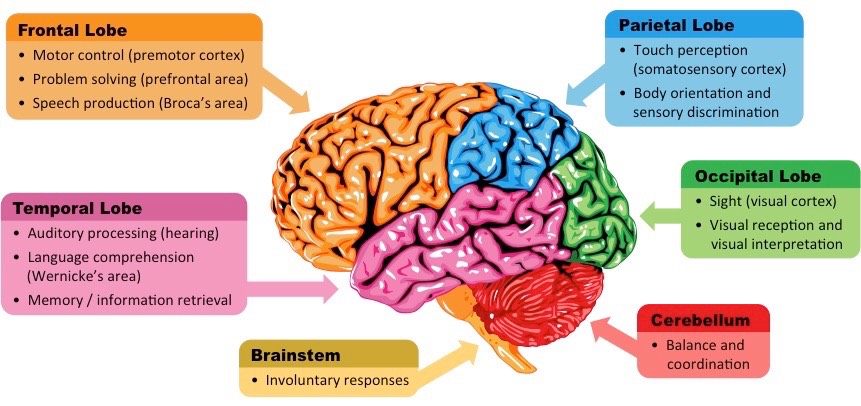![]()
Understanding:
• Different parts of the brain have specific roles
The human brain acts as an integration and coordination system for the control of body systems
- It processes sensory information received from the body and relays motor responses to effector organ
The human brain is organised into clearly identifiable sections that have specific roles
- The major external structures include the cerebral cortex, cerebellum and brainstem
- Internal structures include the hypothalamus, pituitary gland and corpus callosum
External Structures
Cerebral Cortex
- The cerebral cortex is an outer layer of tissue organised into two cerebral hemispheres and composed of four distinct lobes
- The frontal lobe controls motor activity and tasks associated with the dopamine system (memory, attention, etc.)
- The parietal lobe is responsible for touch sensation (tactility) as well as spatial navigation (proprioception)
- The temporal lobe is involved in auditory processing and language comprehension
- The occipital lobe is the visual processing centre of the brain and is responsible for sight perception
Cerebellum
- The cerebellum appears as a separate structure at the base of the brain, underneath the cerebral hemispheres
- It is responsible for coordinating unconscious motor functions – such as balance and movement coordination
Brainstem
- The brainstem is the posterior part of the brain that connects to the spinal cord (which relays signals to and from the body)
- The brainstem includes the pons, medulla oblongata (often referred to as the medulla) and the midbrain
- The brainstem (via the medulla) controls automatic and involuntary activities (breathing, swallowing, heart rate, etc.)
External Structures of the Brain

![]()
Skill:
• Identification of parts of the brain in a photograph, diagram or scan of the brain
Internal Structures
Hypothalamus
- The hypothalamus is the region of the brain that functions as the interface with the pituitary gland
- As such, the hypothalamus functions to maintain homeostasis via the coordination of the nervous and endocrine systems
- The hypothalamus also produces some hormones directly, which are secreted via the posterior pituitary (neurohypophysis)
Pituitary Gland
- The pituitary gland is considered the ‘master’ gland – it produces hormones that regulate other glands and target organs
- The anterior lobe is called the adenohypophysis and secretes hormones such as FSH, LH, growth hormone and prolactin
- The posterior lobe is called the neurohypophysis and secretes hormones such as ADH and oxytocin
Corpus Callosum
- The corpus callosum is a bundle of nerve fibres that connects the two cerebral hemispheres
- It is the largest white matter structure in the brain, consisting of roughly 250 million axon projections
- Damage to the corpus callosum can prevent information exchange between left and right hemispheres (split brain disorders)
Internal Structures of the Brain
 Representation:
Diagram
Photograph
Scan
Representation:
Diagram
Photograph
Scan
